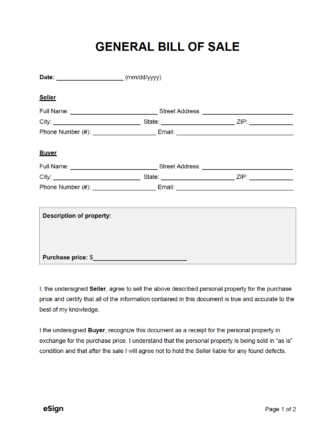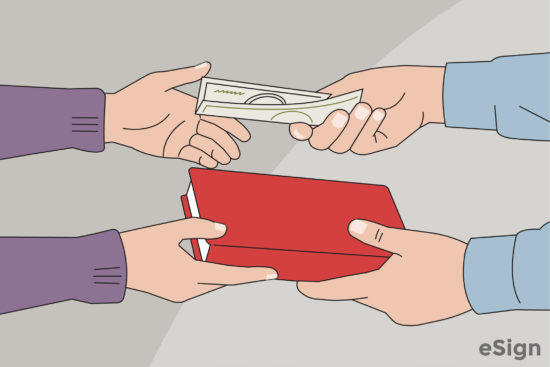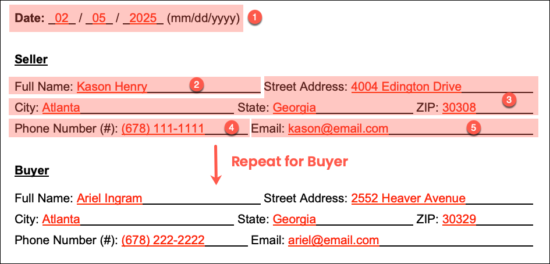By State
- Alabama
- Alaska
- Arizona
- Arkansas
- California
- Colorado
- Connecticut
- Delaware
- Florida
- Georgia
- Hawaii
- Idaho
- Illinois
- Indiana
- Iowa
- Kansas
- Kentucky
- Louisiana
- Maine
- Maryland
- Massachusetts
- Michigan
- Minnesota
- Mississippi
- Missouri
- Montana
- Nebraska
- Nevada
- New Hampshire
- New Jersey
- New Mexico
- New York
- North Carolina
- North Dakota
- Ohio
- Oklahoma
- Oregon
- Pennsylvania
- Rhode Island
- South Carolina
- South Dakota
- Tennessee
- Texas
- Utah
- Vermont
- Virginia
- Washington
- West Virginia
- Wisconsin
- Wyoming
Contents |
What is a Generic Bill of Sale?
A generic bill of sale is a document that proves a sale took place between a buyer and a seller. The simple form contains a description of the sold item, what the buyer paid for it, the contact information of both parties, and their signatures. Once completed, the form is kept by the buyer to prove they are the rightful owner of the property. The form can be used for selling any type of property as long as it is not illegal to own, buy, or sell such an item in the state in which the transaction is taking place.
Property sold using a bill of sale is sold “as-is, where-is”. The buyer does not receive any guarantees regarding the quality, condition, or effectiveness of the item(s) sold.
Commonly Used For
A generic bill of sale can be used for practically anything; popular items sold include:
- Yard sale items
- Electronics
- Clothing
- Furniture
- Kitchenware and appliances
- Garden tools
- Books
- Video games
- Sports gear
- Handmade gifts
Sample
GENERAL BILL OF SALE
Date: [MM/DD/YYYY]
Seller Name: [SELLER FULL NAME]
Address: [SELLER ADDRESS]
Phone Number (#): [SELLER PHONE NUMBER]
Email: [SELLER EMAIL ADDRESS]
Buyer Name: [BUYER FULL NAME]
Address: [BUYER ADDRESS]
Phone Number (#): [BUYER PHONE NUMBER]
Email: [BUYER EMAIL ADDRESS]
Personal Property: [DESCRIPTION OF PERSONAL PROPERTY BEING SOLD]
Purchase Price: $[SELLING PRICE]
I, the undersigned Seller, agree to sell the above-described Personal Property for the Purchase Price and certify that all of the information in this document is true and accurate to the best of my knowledge.
Seller Signature: _________________________
Printed Name: [SELLER NAME]
I, the undersigned Buyer, recognize this document as a receipt for the Personal Property in exchange for the Purchase Price. I understand that the Personal Property is being sold in “as is” condition and that after the sale, I agree not to hold the Seller liable for any defects found.
Buyer Signature: _________________________
Printed Name: [BUYER NAME]
How to Write
Download: PDF, Word (.docx), OpenDocument
Step 1 – Seller + Buyer Information
To begin, the party preparing the bill of sale will need to type or write the following information into the corresponding fields:
- Date
- Name
- Address
- Phone #
- Email address
Step 2 – Property Description + Price
In the grey box, enter a description of the personal property that is being sold. The more descriptive, the better – include any serial numbers, identifying markings, and manufacturing details (such as the year it was made). Below the description, write the amount ($) the buyer agreed to pay for the property.
Step 3 – Signatures
The buyer and seller will need to sign and print their names on the lines provided. eSign can be used for a paperless transaction by providing both parties a means of creating a binding electronic signature to the form. However, printing and signing the bill of sale by hand is valid as well. If desired, the parties can have one (1) or two (2) witnesses observe the signing and include their signatures as well.
Step 4 – Notarization (Optional)
The last section on the second page is reserved for a notary public. If desired, either (or both) parties can have their signature notarized. If the item being sold is not a motor vehicle, firearm, or boat, notarization is not required. Some people opt to have their signatures notarized for further proof that the seller’s signature is real.






